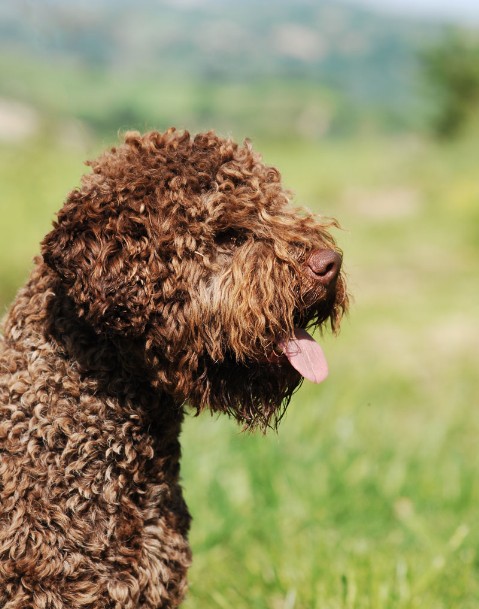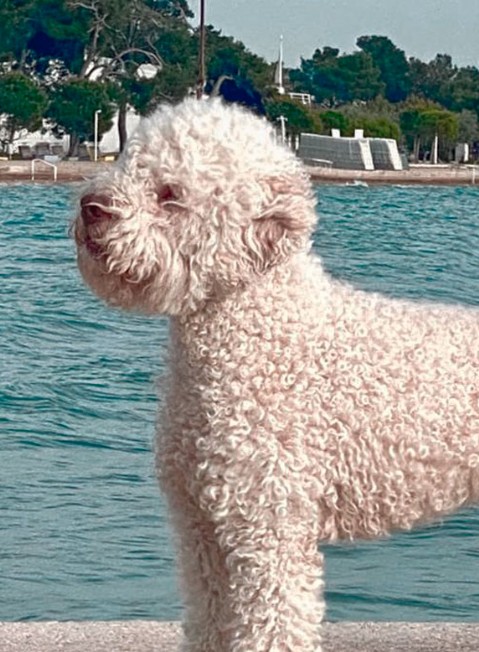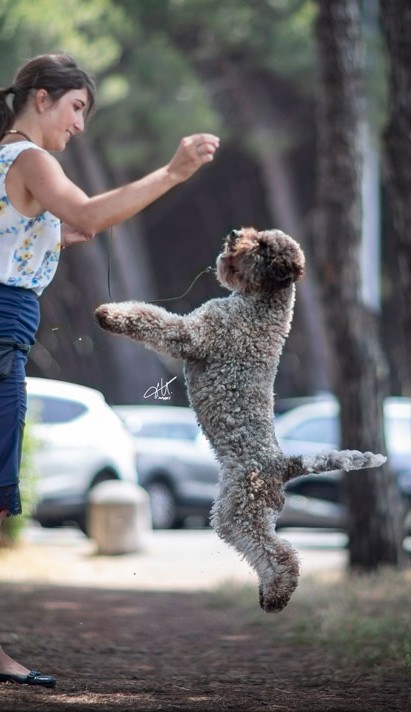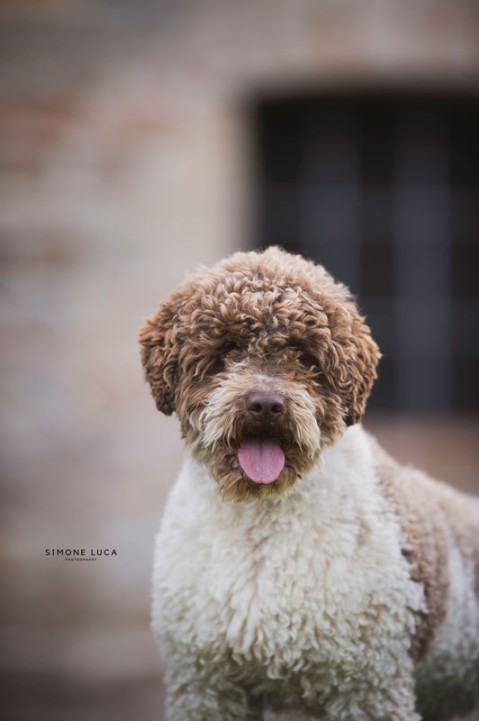Lagotto Romagnolo

It is a dog specialized in the search for truffles on any type of terrain; only race recognized with this attitude. It is an ancient race to be carried in water, present since the sixteenth century, in the valleys of Comacchio and in the Ravenna lagoons and spread, from the nineteenth century, in the plains and hills of Romagna with the specific function of truffle dog. Typical water dog, of medium-small size, mesomorphic, square; the general appearance is rustic, strong and well proportioned, it is possible to understand its functionality in the work. The expression is attentive, intelligent and lively. While working he exhibits passion and efficiency, exploiting the innate attitude to the search and the excellent smell. The hunting instinct has been canceled, so it is not distracted by the wild. Affectionate and very close to the owner, he is also an excellent pet dog, very trainable.

MORPHOLOGICAL STANDARD
- Dr. Antonio Morsiani (Cynotechnical - international ENCI judge) -Chairman of Breed Technical Committee.
- Country of Origin Italy
- Use Dog specialised in truffle-searching on any kind of ground.
- F.C.I. Classification
- Group 8th - retriever, hunting and water dogs.
- Section 3rd - water dogs.
- No 325/bis.
Short Historical Notes
An ancient water retriever dog present as early as in the XVI century in the flat-lowlands of Comacchio and then the flat marshlands of Ravenna. Later it spread over the hills and 1owIand plains of Romagna with the precise function of truffie-hound.
General Appearance
Lagotto is a medium-small size dog, of coarse appearance, stout and very well-proportioned, with thick aind curly hair of woolly texture. The general structure is that of a slight mesomorphous whose torso falls within the square, harmonious in terms of size (etherometry) and disharmonious in terms of profiles (alloidism).
Important Proportions
The length of the head reaches 4/10 of height at the withers. The length of the muzzle is 2/10 lower than that of the skull (namely the muzzle corresponds to 44% approximately of the total head length). The height of the chest is much lower than 50% of the height at the withers and can even go up to 44% of said height.
Behaviour and Character
Lagotto’s function is truffle-searching, a job that it performs with passion and efficiency, thanks to its natural gift for searching and its optimum olfaction Given that its hunting instinct has been removed, it is not distracted by the smell of game in its work and can be considered as the only dog specialised in truffle-searching. It is sober, clever, affectionate, very fond of his owner and easily trainable and also a very good warning dog and dog-companion.

Head
Moderately massive and of trapezoidal form when seen from above. The upper longitudinal axes of the skull and muzzle are slightly diverging. Its length reaches 4/10 of the height at the withers. Cephalic index varies from 50 to 54, (Mesocephaly). Never lower than 50 (dolieoeephaly). Skin adheres to underlying tissues and is smooth and tight.
Cranial Region
The skull is large at the zygoma. Its length corresponds to 56% of the total head length; width (bizygomatic diameter) equals length. Frontally it is arched. In profile it forms a very open arch that is attenuated in the occipital region. Frontal sinuses well developed in three dimensions, marked arch of the eyebrows, nasofrontal depression (stop) not very marked but evident, strong mid-frontal sulcus, short and relatively depressed occipital crest, supraorbital fossae (fontanelle) lightly marked.
Muzzle Region
Nose Schwamm
Bulky, with very wide, open and mobile nostrils. The median groove is very strong. In profile it is on the same line as the nose ridge and protrudes very slightly from the front face of the lips (81°/87° approximately compared to the nose ridge). Colour ranges from light to dark brown depending on the hue of the coat.
Muzzle
Its length is about 2/10 lower than that of the skull (namely the muzzle corresponds to about 44% of the total head length). Its depth or height reaches 8.5/IO of the length of the nose ridge (that is 400/o of the total head length). Its width Is 3.5110 compared lower than length (namely it equals 29% of the total head length). Its lateral faces are s1ightly converging but the front face is quite flat. The upper profile of the nose ridge Is rectilinear, The lower profile of the muzzle is given by the mandible.
Lips
Upper lips are not marked and quite stretched; labial commessure is scarcely visible. Frontally they form - at their disjunction - a wide semi-circle. Labial edges are pigmented in the various hues of brown. Lips are covered by long and quite bristly hair forming whiskers.
Jaws
Marked jaws. The branches of the jaw are quite rectilinear and the mandibular body Is strong and relatively large. Teeth are white and complete in terms of development and number. incisors are set scissors or pincer-like, reversed scissors are tolerated (anteversion of lower incisors).
Cheeks
Flat masseters.
Eyes
Large, rounds and slightly emerging. Iris colour ranges from ochre to dark hazel and brown depending on the coat. They have a sub-frontal location with adherent eyelids with margins pigmented in the various hues of brown.
Eyelashes are very, prominent. Attentive, Intelligent and lively look.
Ears
Moderately largo compared to the volume of the head, with slightly rounded apexes. Triangular shape and quite largo base, attached slightly above the zygomatic arch, they are hanging at rest or slightly raised when the dog is attentive. If extended they reach the nose ridge at 1/4 of Its length. On the ears hair tend to open the curl but Is always very wavy. There Is no part of the ear with short hair. The inner pan of the pinna is covered with hair.
Neck
Slightly arched frontally. Absolutely free of dewlap. It Is slightly shorter than the head (8.5/10 of the total head length); its perimeter can reach the double of its length in males. It is stout, muscular, lean, with oval section and is well detached from the nape
Torso
It has a robust and compact structure (its length equals the height at the withers).
Upper Line
Rectilinear from the withers to the rump.
Withers
They exceed rump level. Although not being very narrow they are quite high and extended backwards.
Back
Rectilinear, very muscular. Its length corresponds to 33% approximately of the height at the withers.
Hips
Short, very robust, slightly convex in profile, well linked up with back and rump Its length corresponds to 1/6 of height at the withers, while width equals and sometimes exceeds length.
Rump
Long (about 3204 of the height at withers), large (on average 2404 of the height at withers), muscular, slightly tilted (coxal inclination ranges from 25° to 30°).
According to coxal inclination
rump is defined as:
- horizontal from 15° to 25°
- tilted from 25° to 35°
- oblique or sunken over 35°
Chest
Strong. It reaches the elbow, its perimeter exceeds height at withers by 1/5, diameter is transverse, at the most it Is in the middle of chest height, its depth roaches 54% of height at withers, its height reaches 44% of height at withers. Frontally it has a VC’), slight careening and then widens again backwards starting from he sixth rib.
Lower Line
The sternoverntral profile shows a long sternal region that tends to from a straight line In a first short section and then continues into a semicircle with very large chord rising gently towards the abdomen that is not too drawn back.
Tail
It Is inserted mid-height, tapered at the top, if extended it brushes past the hock. It is covered with woolly and bristly hair. It Is In a scimitar position at rest and Is markedly raised if the dog Is attentive. During work or when the dog is excited it may also be raised along the line of the back, but never ring-shaped.
LIMBS
Front Limbs
General Examination
Regular perpendicularities both in profile and frontally. The height of the front limbs at the elbow reaches almost 56% of height at the withers.
Shoulder
Long (it reaches 30% of the height at the withers), oblique (52°/55°), muscular, strong, adheres to the chest but Is free-moving. The scapulo-homeral angle ranges from 110° to 115°.
Arm
Muscular, of thin bone structure, its length corresponds to 30% of height at the withers. Its inclination over the horizon ranges from 58° to 60°.
Forearm
Perfectly vertical, oval section, with compact bone structure. Its length corresponds to 36% of height at the withers.
Elbows
Long, prominent, adhere to the chest well but are not too tight, covered with thin skin. As the humeri, they have to be absolutely parallel to the sagittal plane of the torso. The tip of the elbow (oleocranial epiphysis) is located on the vertical lowered from the caudal angle of the scapula to the ground.
Carpus
Frontally It follows the vertical line of the forearm. It is thin, thick and mobile. The pisiform bone Is markedly protruding.
Metacarpus
It is much smaller than the forearm. It is thin, elastic, with minimum subcutaneous cell tissue. Frontally its direction must be on the same vertical plane passing through the forearm. In profile It forms a 75°/80° angle with the ground.
Foot
Roundish and compact front foot with arched and compact digits. Strong and curved nails. Good pigmentation of plantar and digital cushions. Very strong interdigital membrane.
Rear Libs
Overall Examination
Regular perpendicularities. Rear quarters are powerful and well-proportioned to the size of the dog.
Thigh
Long (up to 35% of the length at the withers) with clearly separated and visible muscles, with a slight rear convexity. The axis of the femur, that is markedly oblique top-down and back-forth, has a 80° inclination on the horizontal. Hence, the coxo-femoral angle is about 115°-110°. The vertical plane passing through the thigh, as against the median plane of the body, is parallel.
Leg
It is slightly longer than the thigh (about 36% of the height at the withers), with good bone and muscle structure, and has a marked leg groove. Its inclination en the horizontal ranges from 130° to 135°. Its direction is parallel to the median plane of the body.
Hock
It Is large, thick, lean, with clear-cut bone salience, parallel to the median plane of the body. The tibio-metatarsal angle is about 140°.
Metatarsus
It Is thin, cylindrical, always perpendicular to the ground.
Foot
Rear feet are slightly more oval-shaped than the front feet and falanges are a bit less arched.
Gait
Ordinary pace. Lively trot. Some gallop.
Skin
It adheres to the carpus very well in every region, thin, with scarce subcutaneous cell tissue. It must form no wrinkles. The pigment of mucosas and sclera range from light to dark or very dark brown. The same applies to carpal, digital and plantar cushions.
Coat
Woolly-texture hair, never twisted to form thin cords or curls, semi-rough on the surface, with very thicks curls, ring-shaped, with visible undercoat.
Curls must be homogeneously distributed throughout the body, barring the head where curls tend to open up. Abundant whiskers, beard and eyebrows. Even the cheeks are covered with thick hair. The covering hair and especially the undercoat are water-repellent.
Given that the hair, if not cut, tend to felt, a complete clipping must be performed at least once a year. Felted hair and undercoat must be removed periodically.
Colour
Unicoloured off-white, white with brown or orange spots, brown roan, unicoloured brown (in different hues), unicoloured orange, never black, black and white or grey. Some dogs have a brown or dark brown mask.
Height at the withers
Males: from 43 to 48 cm. (ideal height: 46 cm)
Females: from 41 to 46 cm. (ideal height: 43 cm)
1 cm. tolerance.
Weight
Males: from 13 to 16 kg.
Females: from 11 to 14 kg.
Defects
Every deviation from the above-mentioned characteristics for every region is a defect that must be penalised in the judgement according to its severity and diffusion.
Defects leading to elimination
Convergence of cranio-facial nerves, concave nose ridge, marked and deforming prognathism, partial depigmentation, bilateral strabismus, nnn-curly or totally clipped hair, black or black-dappled coat, presence of dew-claws, amputated tail, height at the withers higher or lower than the limits set.
Defects leading to disqualification
Enognathism, monorchidism, cryptorchidism, total depigmentation, blue eye

PUPPIES
All puppies are equipped with regular pedigree enci / fci, health book, microchip, registration in the canine registry and delivered only after 60 days of birth.
CONTATTI-CONTACT
Via Ca' Cecchino 1
47834 Montefiore Conca
mobile: +393387568224 Monica Benelli
email: info@ilgranaiodeimalatesta.it
TRAINING
Our Lagottos are born and grow in a family environment, they are well socialized with other animals and people before being delivered. We breed only dogs without dysplasia with official result and tested for juvenile epilepsy and sd.